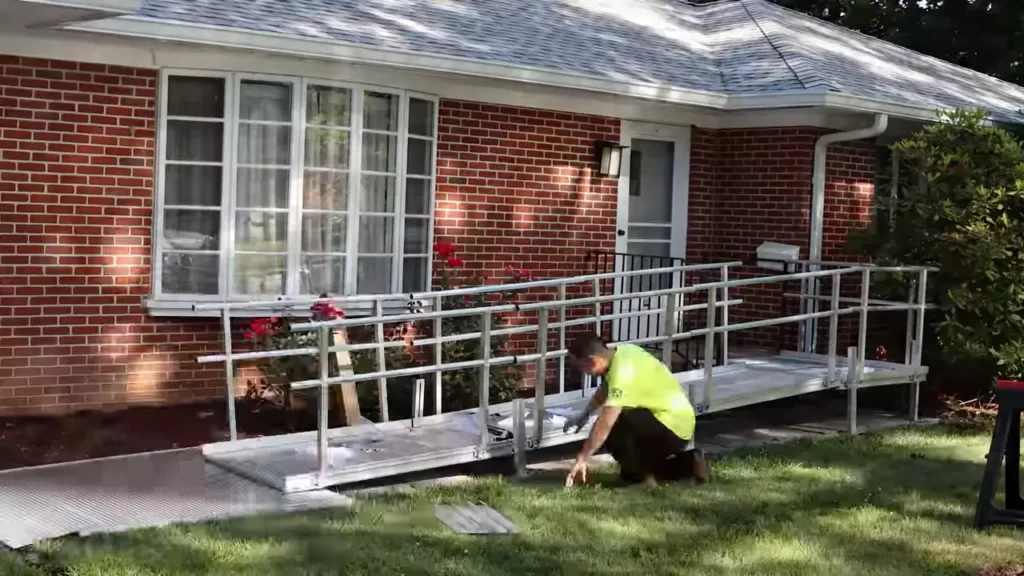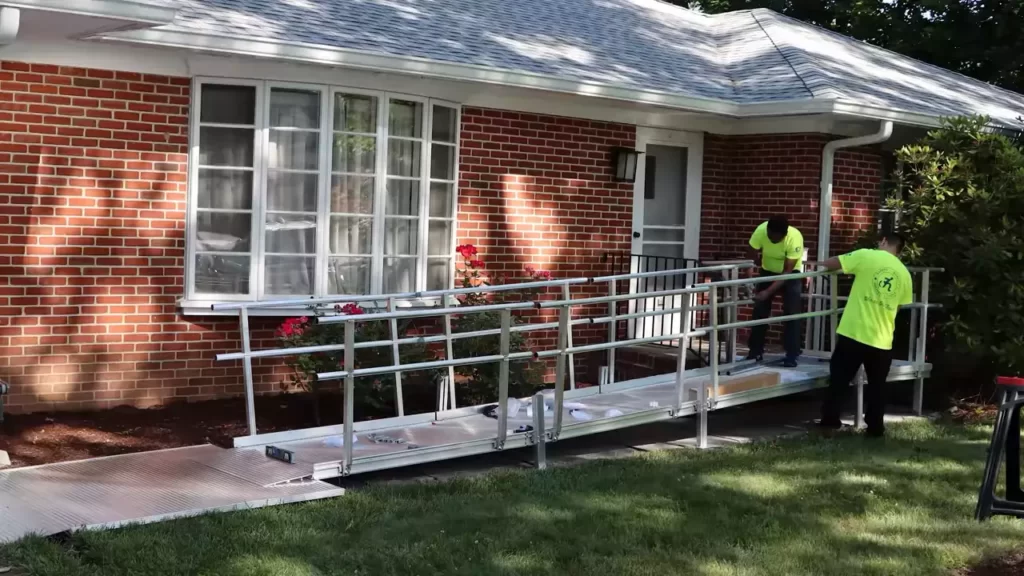To install a wheelchair ramp, measure the height, choose the right ramp type, secure it to the ground, and test its stability for safety. Installing a wheelchair ramp requires proper planning, measurement, and selection of the appropriate ramp type to ensure ease of access for individuals with mobility challenges.
In this guide, we will discuss the steps involved in wheelchair ramp installation, including measuring the ramp height, choosing the proper ramp type, securely fastening it to the ground, and testing its stability to ensure a safe and reliable access solution.
By following these steps, you can successfully install a wheelchair ramp and create a more accessible environment for those in need.
Assessing The Accessibility Needs
Before installing a wheelchair ramp, it is essential to assess the accessibility needs of the individual. This process involves determining the ideal location for the ramp, understanding local building codes and regulations, and evaluating the specific needs of the individual. By taking these steps, you can ensure that the wheelchair ramp meets the necessary requirements and provides safe and convenient access for the individual.

Determining the Ideal Location
To begin, it is crucial to determine the ideal location for the wheelchair ramp installation. Consider the following factors:
- The entrance or exit points: Identify the main entry points that require accessibility.
- Available space: Measure the square footage and evaluate which area can accommodate the ramp most efficiently.
- Obstructions: Take note of any existing obstacles such as steps, uneven surfaces, or narrow pathways that may impede the installation process.
By thoroughly assessing these considerations, you can determine the best location for the wheelchair ramp, ensuring ease of use and safe access for the individual.
Understanding Local Building Codes and Regulations
Before proceeding with the installation, it is crucial to have a comprehensive understanding of the local building codes and regulations. Different regions may have specific requirements regarding wheelchair ramps, including dimensions, materials, and slope angles.
Consult the local government agency or building department, or review the relevant guidelines and regulations available online. Ensure that you comply with these specifications to ensure the ramp’s safety and legality. This step will also help you avoid any potential issues during the inspection process in the future.
Evaluating the Specific Needs of the Individual
Each individual’s accessibility requirements may vary, so it is important to evaluate their specific needs. Consider the following factors:
- Mobility limitations: Determine the type of mobility device the individual uses, such as a wheelchair or scooter. Consider factors like the width and weight of the device.
- Physical abilities: Assess the individual’s physical capabilities, including their ability to navigate slopes, steps, or other potential obstacles.
- Assistance requirements: Determine if the individual requires assistance or if the ramp needs additional features like handrails for stability.
By evaluating these specific needs, you can customize the wheelchair ramp to provide the necessary accessibility and ensure the individual’s safety and comfort.
Choosing The Right Type Of Wheelchair Ramp
Considering Different Ramp Materials
When it comes to choosing the right type of wheelchair ramp, it’s important to consider the materials that the ramp is made of. Different materials offer varying levels of durability, ease of maintenance, and aesthetic appeal. Here are a few common ramp materials to consider:
- Aluminum: Aluminum ramps are lightweight, durable, and rust-resistant, making them a popular choice. They are easy to install and require minimal upkeep, making them an excellent long-term option for both residential and commercial use.
- Wood: Wooden ramps offer a natural, aesthetically pleasing look. They can be customized to match the surrounding architecture, but they require regular maintenance to prevent rot and deterioration. Wooden ramps are often recommended for shorter-term use or temporary installations.
- Concrete: Concrete ramps are the most durable option available. They can withstand extreme weather conditions and heavy use, making them ideal for high-traffic areas. However, concrete ramps require professional installation and are not easily adjustable or portable.

Exploring Portable vs Permanent Ramps
When choosing a wheelchair ramp, it’s essential to consider whether you need a portable or permanent solution. Here are some factors to consider when making this decision:
- Portability: Portable ramps are lightweight and easy to transport, making them ideal for individuals who need to move the ramp frequently. They can be used indoors or outdoors and are typically made of aluminum or lightweight plastic.
- Durability: Permanent ramps are designed to withstand long-term use and are typically made of more durable materials like aluminum or concrete. They are attached to the ground or building and offer a stable, reliable solution for wheelchair accessibility.
- Cost: Portable ramps tend to be more cost-effective upfront and offer more flexibility in terms of placement. Permanent ramps often require professional installation and may involve additional construction costs.
Assessing Ramp Style Options
Wheelchair ramps come in various styles, depending on the specific needs and aesthetics of the installation site. Here are some common ramp styles to consider:
- Straight Ramp: The most basic and common type of ramp, a straight ramp provides a direct path from one point to another. It is suitable for installations with enough space and a minimal number of obstacles.
- Switchback Ramp: If space is limited, a switchback ramp can be a great solution. This style features a series of switchbacks or zigzag turns to accommodate the necessary length within a smaller footprint.
- Modular Ramp: Modular ramps consist of interlocking ramp sections that can be combined to create ramps of varying lengths and configurations. They offer the benefit of customization and can be adjusted to suit different environments.
- Foldable Ramp: Foldable ramps are designed for easy storage and transportation. They can be unfolded and set up quickly when needed and are particularly convenient for travel purposes or temporary installations.
Gathering Tools And Materials
Gathering the necessary tools and materials is an essential first step when it comes to installing a wheelchair ramp. By ensuring you have everything you need before you start the installation process, you can significantly streamline the process and avoid unnecessary delays. In this section, we will discuss the essential tools required for ramp installation, as well as the materials needed for ramp construction or assembly.
Essential Tools for Ramp Installation
Before you begin installing a wheelchair ramp, be sure to gather the following tools:
- Tape Measure: A reliable tape measure will help you accurately measure the length and width of the ramp.
- Level: A level is crucial for ensuring that the ramp is installed on a flat and even surface.
- Drill: A powerful drill will be needed to secure the ramp components together.
- Screwdriver: A screwdriver will be used to tighten screws and fastenings during the installation process.
- Saw: Depending on the type of ramp you are installing, a saw may be necessary to cut materials to the required length or shape.
- Wrench: A wrench will be used to tighten bolts and nuts during the assembly of the ramp.
- Gloves and Safety Glasses: It is important to prioritize safety by wearing protective gloves and safety glasses when handling tools and materials.
Materials for Ramp Construction or Assembly
Alongside the essential tools, you will also need the following materials for ramp construction or assembly:
- Pressure-Treated Wood: Pressure-treated wood is a commonly used material for ramp construction due to its durability and resistance to decay.
- Galvanized Screws: Galvanized screws are highly recommended for securing the ramp components together, as they are resistant to rust and corrosion.
- Concrete: For ramps that require a solid foundation, concrete can be used to secure support posts or anchor bolts.
- Ramp Surface: You may choose to use a variety of materials for the ramp surface, such as non-slip rubber or aluminum plates, to ensure traction and safety.
- Ramp Rails and Handrails: Depending on your specific needs, you may need ramp rails and handrails to provide additional support and safety.
- Fasteners and Connectors: Various fasteners and connectors, such as brackets and hinges, will be needed to securely attach the ramp components together.
By gathering all the necessary tools and materials for ramp installation, you can proceed with confidence, knowing that you have everything you need to successfully complete the project. With these items at hand, you are ready to move on to the next step: planning and preparing the site for ramp installation.

Preparing The Installation Site
When it comes to installing a wheelchair ramp, it’s important to properly prepare the installation site before beginning the actual construction. This ensures that the ramp is safe and functional for its intended purpose. In this section, we will discuss the steps involved in preparing the installation site, including clearing the area, leveling the ground, and removing obstacles and tripping hazards.
Clearing the Area
Before you start the installation process, it is crucial to clear the area where the wheelchair ramp will be placed. This includes removing any debris, rocks, or other objects that may obstruct the ramp’s path. Additionally, make sure there are no low-hanging branches or overgrown vegetation that could interfere with the ramp’s usability.
Leveling the Ground
The next step in preparing the installation site is to level the ground where the wheelchair ramp will be installed. This ensures that the ramp is stable and provides a smooth transition for wheelchair users. Use a level and a measuring tape to determine the areas that need to be leveled. If necessary, you can use fill dirt or gravel to even out any uneven spots.
Removing Obstacles and Tripping Hazards
Once the area is cleared and leveled, it is essential to identify and remove any potential obstacles or tripping hazards that could pose a risk to wheelchair users. This includes removing loose pavers, cracks or potholes in the ground, or any other uneven surfaces that could cause accidents. Additionally, ensure that there are no cables, wires, or other obstructions that may impede the use of the ramp.
By properly preparing the installation site for a wheelchair ramp, you can ensure that the ramp is safe, stable, and accessible for wheelchair users. Clearing the area, leveling the ground, and removing obstacles and tripping hazards are essential steps that should not be overlooked. By taking the time to complete these preparations, you can create a functional and safe ramp that meets the needs of wheelchair users.
Building A Wooden Wheelchair Ramp
Installing a wheelchair ramp can greatly enhance the accessibility of your home or business for individuals with mobility challenges. While there are various materials available for constructing a wheelchair ramp, building one out of wood offers a cost-effective and customizable option. By following a few simple steps, you can create a sturdy and attractive wooden wheelchair ramp that meets your specific requirements.
Measuring and Marking the Ramp Dimensions
The first step in building a wooden wheelchair ramp is to accurately measure and mark the dimensions of the ramp. This includes determining the ramp’s length, height, and width. Using a measuring tape, carefully measure the distance from the highest point where the ramp will start, to the lowest point where it will end. This measurement will determine the ramp’s length.
Next, measure the height of the lowest point where the ramp will end, as this will determine the ramp’s incline. It’s crucial to ensure that the ramp meets the required slope regulations, which typically call for a ratio between 1:12 to 1:20. Once you have these measurements, use a pencil or chalk to mark the positions where the ramp will start and end.
Constructing the Ramp Frame
Once you have measured and marked the ramp dimensions, the next step is to construct the ramp frame. Start by digging holes at the marked positions for the support posts. The number of support posts required will depend on the length and width of the ramp. Usually, placing a support post every 4 to 6 feet is recommended for structural stability.
Next, insert the support posts into the holes and secure them by pouring concrete around the base or using anchoring brackets. Once the support posts are in place, cut the ramp joists to the desired length and attach them to the support posts. Be sure to align the joists properly to ensure a level and sturdy ramp. Additionally, it’s important to check for any potential obstacles or unevenness in the ground and make necessary adjustments.

Installing the Decking and Handrails
With the ramp frame complete, the final step is to install the decking and handrails. Start by attaching the decking boards to the ramp joists using screws or nails, ensuring that they are evenly spaced and securely fastened. It’s recommended to use pressure-treated wood or other weather-resistant materials to prolong the lifespan of the ramp.
Once the decking is in place, install handrails on both sides of the ramp for added safety and support. The height and spacing of the handrails should conform to local building codes and accessibility guidelines. Be sure to use sturdy materials and secure the handrails firmly to the posts to prevent any wobbling or instability.
In conclusion, building a wooden wheelchair ramp requires careful planning and precise execution. By accurately measuring and marking the ramp dimensions, constructing a sturdy ramp frame, and installing the appropriate decking and handrails, you can create a safe and functional ramp that enhances accessibility for individuals with mobility challenges.
Installing An Aluminum Wheelchair Ramp
Wheelchair ramps provide essential accessibility for individuals with mobility challenges. Installing an aluminum wheelchair ramp is a cost-effective and durable solution that can be easily customized to fit the specific needs of the user. In this guide, we will walk you through the installation process of an aluminum wheelchair ramp, including assembling the ramp sections, securing the ramp to the ground, and attaching handrails and safety features.
Assembling the Ramp Sections
Before you begin the installation, make sure you have all the necessary materials and tools handy. To assemble the ramp sections:
- Start by laying out the individual ramp sections on a clean and level surface.
- Align the sections side by side, making sure they are flush against each other.
- Join the sections together using the provided connectors or brackets.
- Secure the sections firmly using screws, following the manufacturer’s instructions.
- Double-check the alignment and stability of the ramp sections to ensure a safe and smooth transition.
Securing the Ramp to the Ground
Properly securing the wheelchair ramp to the ground is crucial to prevent any accidents or shifts in position. Follow these steps to securely attach the ramp:
- Position the assembled ramp in its desired location, ensuring it aligns with the entrance or exit point.
- Mark the spots where the ramp will be anchored to the ground.
- Using a drill, create holes in the marked spots for the anchor bolts.
- Insert the anchor bolts into the holes and tighten them using a wrench or socket set.
- Check the stability of the ramp by applying gentle pressure in different areas. Make any necessary adjustments or tighten the anchor bolts as needed.
Attaching Handrails and Safety Features
Handrails and safety features provide added support and security for individuals using the wheelchair ramp. Here’s how to attach them:
- Position the handrails on the sides of the ramp, ensuring they are at a comfortable height for the user.
- Secure the handrails to the ramp using the provided brackets or fasteners.
- Double-check the stability and strength of the handrails, ensuring they can withstand the weight and pressure.
- If needed, install additional safety features such as non-slip treads or edge guards to enhance the ramp’s usability and safety.
By following these simple steps, you can successfully install an aluminum wheelchair ramp that provides accessibility and freedom of movement for individuals with limited mobility. Remember to carefully read and follow the manufacturer’s instructions for your specific ramp model to ensure proper installation and maximize safety.
Setting Up A Portable Wheelchair Ramp
Installing a wheelchair ramp is an essential step in making a space accessible for individuals with mobility challenges. Whether you need a temporary solution or have limited construction options, a portable wheelchair ramp can be the perfect choice. In this section, we will guide you through the process of setting up a portable ramp, ensuring your loved ones or visitors can move around with ease and independence. Let’s get started!

Unfolding or Extending the Ramp
The first step in setting up a portable wheelchair ramp is unfolding or extending it to its full length. While this may sound simple, it’s important to carefully follow the manufacturer’s instructions to ensure proper functionality and safety.
To begin, locate the release mechanism on the ramp. This may be a latch, button, or lever, depending on the design. Once found, press or pull the release mechanism to initiate the unfolding or extending process.
As the ramp extends, make sure each section locks securely into place. This will prevent any unwanted movement while the ramp is in use. Take a moment to double-check that all segments are fully extended and stable.
Stabilizing and Securing the Ramp
Once the ramp is fully extended, it’s time to stabilize and secure it in place. This step is crucial for ensuring the ramp remains steady and safe during use.
Position the ramp on a flat, even surface. If necessary, use leveling tools such as shims or wedges to eliminate any unevenness. This will prevent any instability or tripping hazards.
Secure the ramp to the ground or floor using appropriate methods according to the manufacturer’s instructions. This may involve using brackets, anchors, or straps. Remember, the goal is to keep the ramp securely in place, so it doesn’t shift or move while in use.
Testing the Stability and Safety of the Ramp
Before allowing anyone to use the ramp, it’s essential to thoroughly test its stability and safety. This step ensures peace of mind and reduces the risk of accidents or injuries.
Walk up and down the ramp with caution, paying attention to any signs of instability, movement, or squeaking. If you notice any issues, stop using the ramp and address the problem promptly. It’s crucial to resolve any stability concerns before allowing individuals to use the ramp.
In addition to personal testing, consider seeking the assistance of a professional or knowledgeable individual who can provide an expert opinion on the ramp’s stability and safety.
Regularly inspect the ramp for any signs of wear and tear. This includes checking for loose screws, damaged surfaces, or any other potential hazards. Ensuring the ramp remains in good condition will help maintain its stability and safety over time.
Setting up a portable wheelchair ramp involves unfolding or extending the ramp, stabilizing and securing it, and testing its stability and safety. By following these steps and consulting the manufacturer’s instructions, you can create a secure and accessible pathway for individuals with mobility challenges. Remember to regularly maintain and inspect the ramp to ensure its longevity and continued safety. Now, go ahead and make a positive difference in someone’s life by providing them with the accessibility they deserve!
Performing A Final Inspection And Testing
Once you have completed the installation of your wheelchair ramp, it is important to perform a final inspection and testing to ensure that everything is in proper working order. This step is crucial to guarantee the safety and accessibility of the ramp for wheelchair users. By following these essential checks, you can have peace of mind knowing that your ramp is ready for use.
Checking for Proper Slope and Rise
The first aspect to assess during the final inspection is the proper slope and rise of the ramp. To achieve optimal accessibility, the ramp should have a gentle slope and a suitable rise. Grab a tape measure to measure the slope ratio, which should be 1:12. In other words, for every 1 inch in vertical rise, there should be at least 12 inches of ramp length. Ensure that the slope is not too steep or too shallow, as it can pose difficulties for wheelchair users.
Assessing the Ramp’s Structural Integrity
Structural integrity is of utmost importance for a wheelchair ramp to provide reliable support. Give the ramp a thorough visual inspection, checking for any signs of damage, such as cracks, loose bolts, or wobbly handrails. Pay close attention to the connection points between different sections of the ramp to make sure they are secure. It is also essential to verify that the ramp is properly anchored to the ground or landing platform, ensuring stability and preventing any risk of collapse or dislodgment.

Conducting Accessibility Tests with a Wheelchair
The final step in the inspection and testing process is to assess the ramp’s accessibility using a wheelchair. This practical test allows you to identify any potential issues and make necessary adjustments. Begin by wheeling a standard-sized wheelchair up and down the ramp, checking for any obstacles or uneven surfaces that may impede smooth movement. Ensure that there is sufficient clearance at the top and bottom of the ramp, allowing for easy entry and exit.
Additionally, test the ramp with a slight incline by placing a weight of at least 200 pounds on the wheelchair. This weight simulates the average weight of a person using a wheelchair. Carefully observe the ramp’s performance under this load, checking for any signs of instability or excessive flexing.
Remember that accessibility tests should be conducted by someone experienced in using a wheelchair, or with the guidance of a wheelchair user, to accurately assess the ramp’s usability from their perspective.
By performing a final inspection and testing the ramp, you can ensure that it meets the necessary criteria for safe and convenient wheelchair access. With each aspect checked, including slope and rise, structural integrity, and accessibility with a wheelchair, you can gain confidence in the reliability of your wheelchair ramp installation.
Regular Maintenance And Safety Considerations
Regular maintenance and safety considerations are essential to ensure the longevity and functionality of your wheelchair ramp. By keeping up with routine maintenance and addressing potential hazards promptly, you can enhance user safety and ensure smooth accessibility for wheelchair users. This section will provide you with practical tips and guidelines to follow when it comes to cleaning and maintaining your ramp, addressing potential hazards and repairs, as well as promoting user safety and accessibility awareness.
Cleaning and Maintaining the Ramp
To keep your wheelchair ramp in top condition, regular cleaning and maintenance are crucial. Here are some important steps to follow:
- Remove debris: Regularly clear the ramp of any leaves, dirt, or other debris to prevent slipping hazards. Use a broom, leaf blower, or a hose to clean the surface.
- Clean the surface: Use a mild detergent and water to clean the ramp’s surface. Avoid using harsh chemicals that may damage the ramp’s material.
- Inspect for wear and tear: Regularly examine the ramp for any signs of damage such as cracks, loose screws, or broken parts. Address the repairs promptly to prevent further deterioration and ensure user safety.
- Apply a protective coating: Depending on the ramp’s material, consider applying a weather-resistant sealant or paint to protect it from the elements and extend its lifespan.
Addressing Potential Hazards and Repairs
Identifying and addressing potential hazards and repairs promptly is crucial for maintaining a safe and functional wheelchair ramp. Here are some important steps to take:
- Inspect for uneven surfaces: Regularly check the ramp for any uneven surfaces, loose connections, or gaps that could pose trip hazards. Make necessary repairs immediately.
- Secure loose screws or bolts: Over time, screws and bolts can become loose due to regular use and exposure to the elements. Regularly check and tighten any loose screws or bolts to maintain stability.
- Check handrails and guardrails: Ensure that handrails and guardrails are securely attached and in good condition. Replace any damaged or worn-out parts promptly to prevent accidents.
- Review slope gradient: Verify that the ramp’s slope gradient adheres to local accessibility guidelines. Adjustments may be needed if the ramp does not meet the recommended slope.
- Provide proper lighting: Install adequate lighting around the ramp to ensure visibility during nighttime use. Well-lit ramps promote safety and accessibility.
Promoting User Safety and Accessibility Awareness
To promote user safety and enhance accessibility awareness, consider the following:
- Create user instructions: Develop clear and concise instructions on how to use the wheelchair ramp safely. Display them prominently near the ramp for easy reference.
- Offer training or education: Provide training sessions or educational material to individuals who use the ramp regularly to ensure they understand proper usage and potential hazards to watch out for.
- Install signage: Clearly mark the ramp’s entrance and exit points with signage to guide wheelchair users and raise awareness of its presence.
- Encourage regular inspections: Promote a culture of regular inspecting and reporting of any issues or potential hazards by both users and facility staff.
Frequently Asked Questions For How To Install A Wheelchair Ramp
How Do You Install A Wheelchair Ramp In Your House?
To install a wheelchair ramp in your house, follow these steps:
1. Measure the width and length needed for the ramp.
2. Choose a suitable material, like aluminum or concrete, based on your budget and requirements.
3. Hire a professional contractor or consult an accessibility expert for guidance.
4. Obtain necessary permits and ensure compliance with building codes.
5. Install the ramp securely and test its stability before use.
What Is The Joist Spacing For A Wheelchair Ramp?
The recommended joist spacing for a wheelchair ramp is usually 16 inches in the center. It’s essential to maintain proper spacing to support the weight and provide stability for wheelchair users.
How Long Should A Ramp Be For 3 Steps?
A ramp for 3 steps should be approximately 6 feet long. It offers a safe and accessible way for people with mobility challenges to navigate the steps. The length of the ramp allows for a gradual incline that is easy to use.
What Is The Correct Way To Push A Wheelchair Up A Ramp?
To push a wheelchair up a ramp: Position yourself behind the wheelchair, place your hands on the handles, and lean forward slightly. Use your legs to provide the necessary strength and push upwards, maintaining a steady pace.
Conclusion
Installing a wheelchair ramp is a crucial step towards promoting accessibility for individuals with mobility limitations. By following the steps outlined in this guide, you can ensure a safe and functional ramp that meets all necessary requirements. Remember to carefully consider factors such as location, materials, and dimensions to create a ramp that suits the needs of your specific situation.
With the right approach and attention to detail, you can make a significant difference in someone’s life by providing them with a means to navigate their surroundings independently and with ease.
